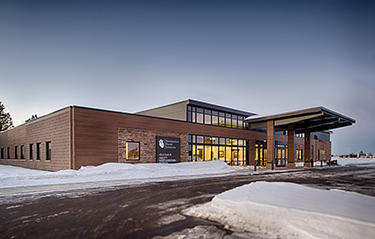|
Subscribe / Renew |
|
|
Contact Us |
|
| ► Subscribe to our Free Weekly Newsletter | |
| home | Welcome, sign in or click here to subscribe. | login |
Construction
| |
 |
February 27, 2020
Hospitals giving way to other care options as providers look to cut costs
M.A. Mortenson Co.

Maggio
|
The health care sector is growing rapidly, with the Bureau of Labor and Statistics predicting a 14% increase in health care employment by 2028.
While this is an exciting time for the field, growth presents both challenges and opportunities for health care systems. In a 2018 survey conducted by M.A. Mortenson Co., two-thirds of industry leaders expected to increase their investment in medical facilities to remain competitive. However, of those polled, 35% reported insufficient capital resources as their biggest challenge.
In this environment, health care systems are innovating to meet the demands of the market and the needs of patients by embracing more cost-efficient and time-sensitive approaches to delivering their real estate needs.
On a foundational level, health care systems are evolving to meet the market demands of a changing demographic and transition to a value-based care model brought on by the Affordable Care Act.
Hospitals, traditionally viewed as the primary patient care facility, are giving way to the rise of networks of retail clinics, freestanding urgent care centers, and ambulatory surgery and specialty facilities as part of a hub-and-spoke real estate strategy. These sorts of facilities are more cost effective to construct and operate and can be delivered on a shorter timeline.
Improving access
In the hub-and-spoke model, the hospitals at the center treat only the most acute cases, with the primary focus on keeping patients out of the hospital through early intervention in the form of primary and ambulatory care. This approach ultimately keeps people healthier and in turn reduces a health system’s operating expenses, allowing it to be most efficient with its valuable capital.
From a patient perspective, this trend translates into more access to preventive and routine care in convenient locations through networks of surrounding facilities. Freed from some of the complex regulatory requirements of hospitals, these facilities are often able to integrate retail-like amenities to create a more comfortable, welcoming environment.
Behavioral health treatment facilities are at the forefront of this trend as one of the most significant growth areas in the health care sector. In the past, mental health care was often associated with a strong cultural stigma and largely inaccessible to patients who were not able or willing to seek care in a hospital environment. This system has led to a scarcity of available beds for patients in crisis. In fact, Washington ranks second to last in the nation in terms of the availability of beds at in-patient facilities, according to a recent report from the Seattle Times, leaving nearly a quarter of adults in our state unable to get the care they need.
To address these limitations, the governor’s office has spearheaded investment into behavioral health care facilities, which many expect to reach $1 billion in the coming years. As part of a paradigm shift, these resources are not solely directed toward large state-run hospital facilities but also fund smaller community hospitals and clinics dedicated to mental health care. An example is the 115-bed Smokey Point Behavioral Hospital in Marysville constructed by Mortenson in 2017.
For health care systems in Washington, this investment presents an opportunity to expand their operations, reach and impact through new facilities. With that expansion comes a need for more physicians, nurses and social workers to care for this population.
The University of Washington Medical Center’s future Behavioral Health Teaching Facility on the Northwest Hospital campus is an example of this trend in action. With funding from the state of Washington, the facility is expected to add to Washington’s bed capacity and provide a training environment for the next generation of caregivers.
Design-build and IPD
With the growing need to expand quickly to meet patient needs and stay ahead of competition, many health care systems are shifting the way they deliver new facilities.
When asked in a 2018 survey conducted by M.A. Mortenson what project delivery method their organization would most prefer to utilize, 54% of industry leaders responded with either design-build or integrated project delivery (IPD). This represents a dramatic transformation in a market sector that for decades has leaned towards more traditional delivery methods like design-bid-build and CM-at-risk.
Embracing more new-age approaches like design-build and IPD allow for greater collaboration, shorter timelines and a more nimble design and construction process. IPD is a flexible model that adapts to each individual project but generally begins with the selection of teams and the finalization of a value-based fee structure.
Instead of working separately, everyone from architects to trade partners and fabricators are often co-located to foster increased collaboration. Most teams work from a single model, providing real-time cost and constructability feedback, allowing for the most efficient use of resources, and eliminating the need for costly and time-intensive design iterations.
Both the University of Washington and Kaiser Permanente are recognized as national leaders in IPD. Currently, Mortenson and design partner HOK are leveraging the IPD method to target-value design a new 150,000-square-foot ambulatory facility as part of the expansion of Kaiser Permanente’s Everett Medical Center. In addition to design consultants, key trade partners and suppliers are actively engaged in the process at this early stage, ensuring the ideas and perspectives of those who are eventually responsible for building the project are heard during design. These interdisciplinary teams are combining their expertise to explore design solutions that support prefabrication and modularization and shorten the overall construction duration.
The Allina & Cuyuna Regional Medical Center in Minnesota provides an example of IPD’s potential. Allina’s Minneapolis Heart Institute had short-term lease that was set to expire, making the need for a new facility urgent.
Mortenson helped foster a new partnership with Cuyuna Regional Medical Center that brought together stakeholders from two separate organizations. The project embraced an integrated delivery model designed to achieve the level of collaboration and speed that the complex project required, completing the new health care center in 10 months.
From delivery models to design features and patient experience, health care facilities are evolving to meet regulatory changes and patient needs in a highly competitive market.
As one of the most rapidly growing sectors in our state and nationally, health care will continue to challenge the design and construction field to innovate solutions that deliver shorter timelines and a more efficient use of resources. With these challenges comes the opportunity to increase access, overcome limitations, and build facilities that will serve communities for many years to come.
Bryan Maggio is a health care market executive for M.A. Mortenson Co.
Other Stories:
- Hospital projects in rural areas face extra obstacles
- UW’s new health sciences building will be a hub for 21st-century care
- Good design takes some stress out of visiting the hospital
- Building out this new hybrid OR was no simple operation
- Fire dampers: one more way hospitals can save lives
- CHP systems: a powerful energy-saving tool for hospitals
- A look inside the Cure Factory, Seattle Children’s new cell therapy lab
- Health care could look a lot different in 2040, so get ready
- Here’s what’s in store for health care in the Northwest
- Integrated project delivery offers risks and rewards for team members
- How welcoming design can improve outcomes for patients — and staff



